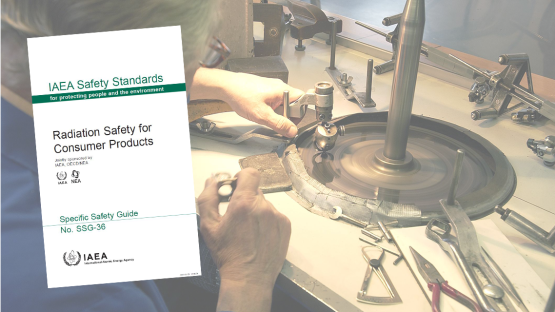Various consumer products such as smoke detectors, high intensity discharge lamps, and artificial gemstones contain small amounts of radioactive material. Such products are available in commercial outlets worldwide and can also be bought over the Internet — and their safety is of utmost importance to regulators.
The IAEA’s ‘Radiation Safety for Consumer Products’, issued today, contains guidance for national regulatory bodies and suppliers to ensure the safety of consumer products containing small quantities of radionuclides.
“Once sold to the public, it is virtually impossible to control the use and disposal of these consumer products,” said Miroslav Pinak, Head of the IAEA Radiation Safety and Monitoring Section. “Hence, before the regulatory body authorizes their manufacture, it needs to confirm that the radiation doses will be sufficiently low so as to comply with international standards and norms for protection of the public.”
The role of the regulatory bodies is to ensure that any products for sale to the public that contain small amounts of radioactive material are fundamentally safe.
The Safety Guide also establishes a process of cooperation between regulatory bodies in countries that manufacture and those that import these products. In some cases, safety assessments conducted in the country of manufacture are not accepted by importing countries, leading to delays in the international trade of these goods. “A lot of extra work is done for products that are probably quite harmless, with limited benefit to radiation protection of consumers and those involved in the manufacturing process of such items,” said Pinak.
It is important that regulatory bodies perform a thorough review before approving the manufacturing of these products. If that can be guaranteed, then regulatory bodies in importing countries can be equally satisfied that such products are safe, Pinak further explained. “Applying the safety guidelines and procedures in this Safety Guide will help regulatory bodies in both manufacturing and importing countries to do their job and provide appropriate protection for the public who wish to use these products.”
The Safety Guide also addresses, for example, the potential concerns with the production of artificially-coloured gemstones. The irradiation of gemstones in research reactors is a widespread practice carried out to enhance their colour and thereby increase their market value. Immediately after irradiation, these stones contain residual radioactive material.
In order to protect those who cut and polish these gemstones, as well as the general public who buy and wear them, strong regulatory control is necessary. In practice, this means that appropriate procedures are in place to protect the workers who must handle the irradiated gemstones within the reactor facility and that the gemstones are not released to cutters, jewellers or the public until the radiation is reduced to trivial levels.
The Safety Guide is co-sponsored by the Nuclear Energy Agency of the Organisation for Economic Co-operation and Development.
Strengthening Safety
Enforcing regulation and safety standards are a national responsibility. In this context, the safety guide offers case studies to demonstrate how steps can be taken to harmonize approaches among States, providing guidance on justification and application of the criteria for exemption from regulatory control of some consumer products.
The Safety Guide also addresses the decision-making mechanisms to allow the manufacture or import of consumer products as well as the various stages of the life cycle of these items following manufacture, including transport, storage, provision, use, recycling and disposal.
The IAEA Safety Standards
This Safety Guide is latest addition to the IAEA Safety Standards series. It contributes further to the core IAEA objective to protect people from harmful effects of exposure due to ionizing radiation, for the safety of radiation sources, and the protection of the public and environment, when using nuclear science and technology.
‘Radiation Safety for Consumer Products’ is based on both the administrative and radiation protection requirements established in IAEA Safety Standard Series as General Safety Requirements Part 3.



